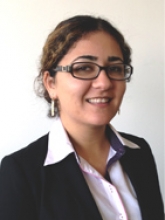ChEMS Seminar: Understanding the Optoelectronic Properties of Organic Semiconductors Using First-Principles Computation

Abstract: Organic semiconductors are a highly tunable class of optically active materials that are promising as next-generation solar energy materials. Design of new organic materials for efficient optoelectronics relies on understanding their excited-state electronic structure, which is significantly influenced by both chemistry and condensed phase morphology. Here, I will present first-principles computational studies aimed at understanding the spectroscopic properties of highly ordered arrays of organic materials. For a series of crystals composed of linear acene molecules, our calculations agree quantitatively with transport gaps extracted from photoemission spectroscopy and conductance measurements, as well as with measured polarization-dependent optical absorption spectra. Moreover, introducing a new analysis of the electron-hole correlation function, we demonstrate the tunability of optical excitations (excitons) via solid-state structure. Lastly, I will introduce studies aimed at understanding the structure-property relationships within biologically inspired molecular nanowires composed of perylene diimides. Collectively this work demonstrates that the optical and electronic properties of condensed phase organic molecules can be designed by tuning both the chemistry and solid-state structure.
Biography: Sahar Sharifzadeh is an assistant professor at Boston University within the Departments of Electrical & Computer Engineering and Physics, and the Division of Materials Science & Engineering. She obtained her B.S. in electrical engineering & computer science from the University of California, Berkeley in 2003 and her Ph.D. from Princeton University in 2009 where, under the guidance of Prof. Emily Carter, she developed and applied a first-principles theory for describing molecular adsorption on metals. She joined the Molecular Foundry at Lawrence Berkeley National Laboratory in 2009, working in the group of Prof. Jeffrey Neaton, first as a postdoctoral fellow and subsequently project scientist. Her research at Berkeley Lab focused on understanding optical excitations in organic semiconductors for photovoltaic applications. She joined Boston University in 2014, where she continues research on understanding the optoelectronic properties of nanostructured materials using first-principles theory.
Share
Upcoming Events
-
MSE Special Seminar: Decarbonizing Industries for a Climate-resilient Future - From Renewable Energy to Sustainable Material Recovery
-
MAE 298 SEMINAR: Technology Developments for FIR Bolometric Detector Focal Plane Assemblies
-
CBE 298 Seminar: The Wisdom of the Crowd: Watching Bacterial Collectives (Re)shape Themselves
-
CEE Seminar: BIM and the Digital Twin
-
MSE Special Seminar: Revolutionizing Battery Technology - Engineering Quantum Materials for Enhanced Safety and Performance in Solid Electrolytes
